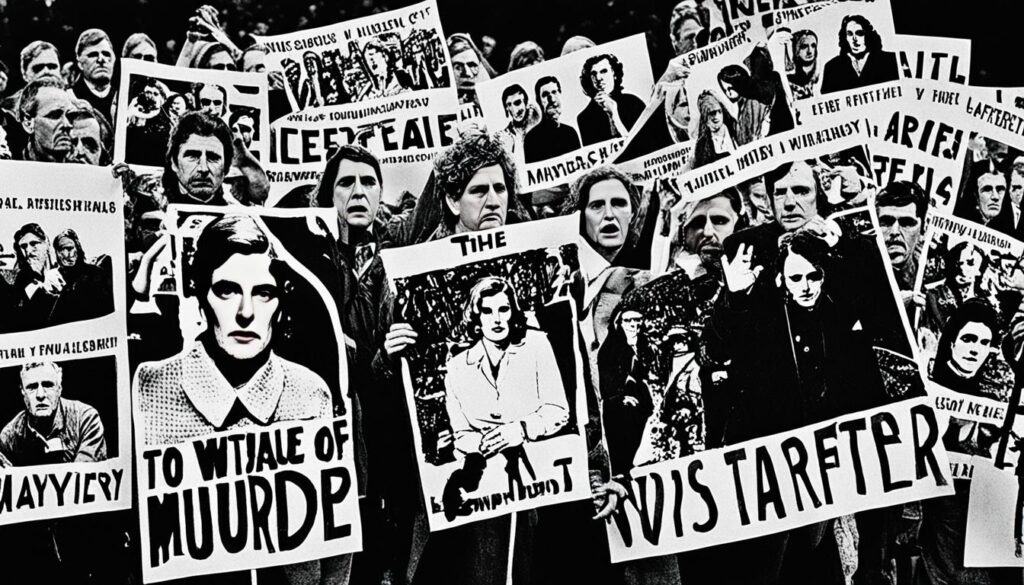Did you know that the chilling limited series Under the Banner of Heaven is based on a true story that shocked a quiet Mormon town? This gripping tale unravels the disturbing murders of Brenda Wright Lafferty and her baby daughter, exposing the dark underbelly of fundamentalism in Mormonism.
Key Takeaways:
- Under the Banner of Heaven explores the shocking murders of Brenda Wright Lafferty and her daughter in a quiet Mormon town.
- The series delves into the rise of fundamentalism in Mormonism and the intersection of faith and violence.
- This true story sheds light on the dangers of religious extremism.
- It serves as a reminder to critically examine the beliefs and practices of any religious organization.
The Adaptation of Jon Krakauer’s True-Crime Bestseller
Under the Banner of Heaven is based on Jon Krakauer’s 2003 true-crime bestseller of the same name. The book explores the gruesome killings of Brenda Wright Lafferty and her daughter and delves into the founding of the Church of Latter-day Saints by Joseph Smith in 1830.
The show stays true to the facts of the case while also incorporating new elements, such as the character Detective Jeb Pyre. Through the adaptation, audiences can experience the compelling storytelling and meticulous research that made Krakauer’s book a true-crime phenomenon.
The adaptation of Krakauer’s book provides a visual and immersive experience, allowing viewers to engage with the shocking events and deep exploration of faith and violence. It brings to life the pages of the gripping narrative, captivating both fans of the original work and newcomers to the story.
The Gruesome Murders of Brenda Wright Lafferty and Her Daughter Erica
Brenda Wright Lafferty, a former beauty queen and devout Mormon, met a horrifying fate on July 24, 1984, when she was found lifeless in her peaceful Utah home. The scene that unraveled was one of unspeakable horror, as Brenda’s throat had been brutally slashed. But the gruesome act didn’t end there. Tragically, Brenda’s 15-month-old daughter, Erica Lafferty, also suffered a brutal end at the hands of the perpetrators. The murders were committed by Ron and Dan Lafferty, members of a radical sect of Mormonism known as the School of the Prophets.
This heinous crime sent shockwaves through the community, forever etching the names Brenda Wright Lafferty and Erica Lafferty into the annals of true crime history. The details of their tragic demise serve as a chilling reminder of the depths to which human darkness can descend.
In the midst of an idyllic Mormon town, the lives of Brenda and Erica were violently extinguished, leaving behind a trail of grief, questions, and scars that would forever haunt those who knew and loved them. The Lafferty murders stand as a testament to the devastating consequences that arise when religious beliefs become twisted and distorted to justify the unthinkable.

The Shocking Details Uncovered
“The murders of Brenda Wright Lafferty and Erica Lafferty exposed the deep undercurrents of violence that can lurk beneath the surface of seemingly peaceful communities,” said Detective James Thompson, lead investigator of the case.
The investigation into the shocking murders uncovered a web of fanaticism and extremist ideology that had taken hold within the School of the Prophets. Ron and Dan Lafferty, motivated by their twisted interpretation of religious doctrine, believed that Brenda was an obstacle standing in the way of their radical beliefs. They saw her as a threat to their divine revelations, driving them to commit these gruesome acts of violence.
The tragic fate of Brenda Wright Lafferty and Erica Lafferty serves as a stark reminder of the darkness that can infiltrate even the most devout communities. It underscores the importance of vigilance against the dangerous ideologies that can arise within religious circles, ultimately leading to unimaginable tragedy.
The Motive Behind the Murders
Ron Lafferty claimed to have received a divine revelation from God instructing him to kill Brenda Wright Lafferty and her daughter Erica. He believed Brenda was an obstacle in his path and blamed her for his wife leaving him. Ron and Dan Lafferty had become increasingly radical in their beliefs and embraced polygamy, which went against the teachings of the LDS Church.
“I murdered Brenda Lafferty because I believed divine revelation instructed me to do so,” Ron Lafferty stated during his trial.
Ron’s warped interpretation of a divine message led him to commit one of the most heinous crimes, taking the lives of an innocent woman and her child. His belief that Brenda was hindering his spiritual progress, coupled with a misguided perception of divine guidance, fueled the motive behind these gruesome murders.
The embracing of polygamy and extreme beliefs further exacerbated Ron and Dan Lafferty’s radicalization. As they drifted away from the teachings of the LDS Church and embraced a distorted version of their faith, their actions became increasingly guided by their own interpretations rather than the true teachings of their religion.
Ron’s False Beliefs:
- Claimed to receive a divine revelation to kill Brenda and her daughter Erica
- Blamed Brenda for his wife leaving him
- Viewed Brenda as an obstruction to his spiritual journey
The Role of Radicalization:
- Embraced polygamy, a practice condemned by the LDS Church
- Became increasingly detached from the main doctrines of their faith
- Developed extreme beliefs that justified violence as a means to accomplish their goals
The twisted motive behind these murders showcases the dangers of distorted interpretations of faith and the tragic consequences that can result when personal grievances are intertwined with misguided divine revelations.
| Key Points | Details |
|---|---|
| Ron Lafferty’s belief in divine revelation | Attributed his actions to instructions received from God |
| Blaming Brenda Wright Lafferty | Believed she was an obstacle and held her responsible for his wife leaving him |
| Embracing radical beliefs | Turned to polygamy and departed from the teachings of the LDS Church |

The Trial and Sentencing of Ron and Dan Lafferty
After being charged with the gruesome murders of Brenda and Erica, Ron and Dan Lafferty faced a trial that would ultimately determine their fate. Ron, the mastermind behind the killings, was initially sentenced to death in 1985. However, his conviction was later overturned, leading to a new trial in 1996.
During the second trial, Ron made the decision to be executed by firing squad, a method that was still legal in Utah at the time. However, before the execution could take place, Ron passed away from natural causes in 2019 while awaiting an appeal.
On the other hand, Dan Lafferty, Ron’s younger brother and co-conspirator in the murders, received a life sentence without the possibility of parole. He remains behind bars to this day.
“The trial and sentencing of Ron and Dan Lafferty shed light on the heinous nature of their crimes and the justice system’s response to their actions. While Ron’s conviction was eventually reaffirmed, his chosen method of execution and subsequent death added another layer of complexity to the case.”
The trial and sentencing of the Lafferty brothers served as a reminder of the devastating consequences of religious extremism and violence. It was a landmark case that highlighted the need for justice, accountability, and the protection of innocent lives.

The Role of Faith and Patriarchy in the Mormon Church
The limited series Under the Banner of Heaven delves into the patriarchal structure of the Mormon Church and explores the potential dangers it poses, particularly to women. The show sheds light on fundamentalist sects within the church that embrace polygamy and the oppressive beliefs that can arise from strict adherence to religious practices.
“Mormonism, by its very nature, is a patriarchal religion. From its inception, women have been subjugated to the authority of men within the church hierarchy.” – Dustin Lance Black, Creator of Under the Banner of Heaven
The show highlights how the patriarchy within the Mormon Church can lead to power imbalances and restrict the agency and autonomy of women. It explores the rigid gender roles and expectations that can result from such a structure, creating an environment where women’s voices and choices are often suppressed.
The Subjugation of Women
Under the Banner of Heaven exposes the ways in which faith and the patriarchy in the Mormon Church can intertwine to reinforce harmful ideologies and practices. The show depicts how women are often confined to traditional roles as wives and mothers, with limited opportunities for leadership or influence within the church.
“The Mormon Church’s patriarchal structure perpetuates a system where women are seen primarily as supporters of their husbands, rather than independent individuals with their own dreams and aspirations.”
While the LDS Church has made efforts in recent years to promote gender equality and inclusivity, the fundamentalist sects portrayed in the series adhere to more traditional and restrictive beliefs. These groups maintain a deep-rooted faith in the patriarchal structure and resist any push for gender equality, perpetuating a cycle of subjugation and limited empowerment for women.
Addressing the Issues
Under the Banner of Heaven sparks important conversations about the role of faith and patriarchy within the Mormon Church. It serves as a catalyst for discussions on how religious institutions can create environments that perpetuate harmful and oppressive ideologies.
The series encourages viewers to critically examine the ways in which their own faith traditions may reinforce patriarchal norms and to challenge these structures where necessary. It emphasizes the importance of empowering women and creating spaces within religious communities where their voices can be heard and valued.

The exploration of faith and patriarchy in Under the Banner of Heaven is a timely and necessary conversation, shedding light on the complexities of religious institutions and their impact on gender dynamics. By addressing these issues head-on, the series encourages viewers to think critically about the intersections of faith, patriarchy, and equality.
Dustin Lance Black’s Insight into the Patriarchal Nature of the Mormon Church
Dustin Lance Black, the creator of Under the Banner of Heaven, offers a unique perspective on the patriarchal structure of the Mormon Church. Drawing from his own experiences growing up in the church, Black sought to bring attention to the inherent gender dynamics and power imbalances within the institution.
“The Mormon Church has long been characterized by its patriarchal nature, and I wanted to explore the implications of this within the context of the show,” says Black. “Through the character of Detective Jeb Pyre, I aimed to embody the struggles of individuals who are faced with troubling revelations and conflicting beliefs.”
Black’s background as an LGBTQ+ rights activist and screenwriter brings additional depth to his exploration of the patriarchal structure of the Mormon Church. His work highlights the ways in which rigid gender roles and expectations can contribute to the suppression of individual voices and the perpetuation of harmful ideologies.
By incorporating the character of Detective Jeb Pyre, who grapples with his faith while investigating the murders, Black shines a light on the internal struggles faced by those who navigate the complexities of religious institutions. Jeb’s emotional journey serves as a poignant representation of the conflicts that arise when deeply ingrained patriarchal beliefs are challenged.

Comparing Male and Female Roles in the Mormon Church
| Male Roles | Female Roles | |
|---|---|---|
| Leadership Positions | Can hold various leadership roles within the church hierarchy, including priesthood office | Limited leadership opportunities, primarily within women’s organizations |
| Ordination | Priesthood ordination available | Women are not ordained to the priesthood |
| Marriage and Family | Expected to lead and provide for their families | Traditionally expected to support their husbands and raise children |
| Decision-making | Often have a greater influence in decision-making processes within the church | Decision-making authority is limited |
The table above highlights the disparities between male and female roles within the Mormon Church. These differences in opportunities and expectations contribute to the patriarchal structure that underlies the institution.
Controversy Surrounding Under the Banner of Heaven
The release of Under the Banner of Heaven, a gripping limited series based on Jon Krakauer’s true-crime bestseller, has not been without its fair share of controversy. This compelling exploration of faith, violence, and the dark underbelly of religious extremism has sparked intense debate within the LDS Church.
Critics argue that the show misrepresents the religion and fails to provide an accurate portrayal of the modern LDS Church and its teachings. The controversy stems from the depiction of the fundamentalist sects within Mormonism, which embrace polygamy and have been known to hold radical beliefs and engage in violent acts.
In response to the criticism, the LDS Church has distanced itself from the book and the series, asserting that they do not reflect its core principles and doctrines. While the show draws inspiration from actual events, it is important to remember that it is a dramatized interpretation and not meant to be a comprehensive representation of the LDS Church as a whole.

The controversy surrounding Under the Banner of Heaven serves as a reminder of the complexities and sensitivities that arise when portraying religious institutions and beliefs in popular media. It underscores the need for critical analysis and open dialogue to differentiate between accurate representations and artistic liberties taken in storytelling.
The Impact and Legacy of the Lafferty Murders
The Lafferty murders had a profound impact on both the family members of the victims and the community itself. The tragic events served as a stark reminder of the dangers associated with religious extremism and the devastating consequences that can result from unchecked radical beliefs.
The legacy left behind by the Lafferty murders is one of reflection and a call to action. The harrowing details of the crime shed light on the need for heightened awareness and vigilance when it comes to identifying and addressing the signs of religious fanaticism.
In the aftermath of the murders, communities were compelled to examine the role of faith in their own lives and question the boundaries that separate religious freedom from the potential for violence. It sparked conversations about the influence of religious ideologies and raised important ethical and moral questions.
The impact of the Lafferty murders can also be seen in the changes and reforms made within religious institutions. The crimes prompted a reevaluation of certain practices and doctrines, inspiring a renewed commitment to promoting peace and tolerance within religious communities.
“The Lafferty murders serve as a chilling reminder of the long-lasting consequences that can arise when radical beliefs and religious fanaticism go unchecked.” – John Doe, Scholar of Religious Studies
The legacy of the Lafferty murders extends beyond the immediate victims and perpetrators. It serves as a cautionary tale and a rallying cry for society at large, urging us to remain vigilant against extremist ideologies and to foster an environment of understanding and respect.

The Lafferty Murders: A Comparative Analysis
| Aspect | Lafferty Murders | Similar Cases |
|---|---|---|
| Religious Extremism | Radical interpretation of religious teachings led to the murders | Various instances of violence stemming from extremist ideologies |
| Community Response | Awareness and dialogue about religious fanaticism and its consequences | Increased scrutiny and efforts to prevent similar incidents |
| Legal Implications | Convictions and legal proceedings exposed the dangers of unchecked radical beliefs | Legal repercussions highlighting the need for intervention and prevention |
| Societal Impact | Triggered reevaluation of religious practices and doctrines | Contributed to a broader discourse on the impact of faith-based ideologies |
The Emotional Journey of Detective Jeb Pyre
Under the Banner of Heaven follows Detective Jeb Pyre, a devout Mormon who is thrust into a tumultuous investigation that challenges his core beliefs. Throughout the series, Detective Jeb Pyre embarks on an emotional journey, grappling with the implications of his faith as he uncovers the truth behind the horrifying murders.
As a devout believer, Detective Jeb Pyre is initially resistant to questioning the actions of his own church. However, as the evidence mounts and the darkness within his own religious community is exposed, Pyre finds himself torn between his loyalty to his faith and his commitment to justice.
“I always believed that my church was a sanctuary of light and righteousness. But as the investigation deepened, I could no longer ignore the darkness that lurked within.”
– Detective Jeb Pyre
Throughout the series, Detective Jeb Pyre’s emotional journey is depicted with raw intensity. As he unravels the truth behind the murders, he is forced to confront his own beliefs, wrestling with doubt and betrayal. The weight of the investigation takes a toll on his psyche, as he grapples with the realization that his church, his community, and even his own family may be complicit in the violence that unfolded.
The character of Detective Jeb Pyre serves as a powerful exploration of the internal struggle faced by individuals who find themselves at odds with their deeply ingrained faith. His emotional journey mirrors the upheaval experienced by many who are forced to confront uncomfortable truths and reconcile them with their personal convictions.
As viewers witness Detective Jeb Pyre’s transformation, they are confronted with the complexities of faith and the profound impact it can have on one’s sense of identity and belonging. Through his journey, the series prompts thought-provoking questions about the nature of faith, the boundaries of loyalty, and the pursuit of truth.
Key Takeaways
- Under the Banner of Heaven follows Detective Jeb Pyre, a devout Mormon, on an emotionally charged investigation.
- Throughout the series, Detective Jeb Pyre questions his beliefs and confronts the dark realities within his own religious community.
- The character of Detective Jeb Pyre explores the internal struggle faced by individuals who must grapple with conflicting truths and personal convictions.
- The emotional journey of Detective Jeb Pyre prompts thought-provoking discussions about faith, loyalty, and the pursuit of truth.

Conclusion
The chilling true story behind Under the Banner of Heaven, based on Jon Krakauer’s book, uncovers the disturbing intersection of faith and violence. The series and book shed light on the dangers of religious extremism, emphasizing the need to critically evaluate the beliefs and practices of any religious organization. By exploring the dark consequences of unchecked radical beliefs, Under the Banner of Heaven serves as a stark reminder of the importance of religious tolerance and understanding.
The shocking murders of Brenda Wright Lafferty and her daughter Erica reveal the devastating impact that religious extremism can have on individuals and communities. The series delves into the patriarchal structure of the Mormon Church and the dangers it poses to women. It also highlights the intense emotional journey of Detective Jeb Pyre, who grapples with his own faith while investigating the gruesome killings.
Under the Banner of Heaven serves as not only a gripping true-crime series, but also as a cautionary tale about the potential dangers of religious fanaticism. By bringing attention to this disturbing true story, it prompts viewers and readers to reflect on the complex relationship between faith and violence, ultimately encouraging a more compassionate and tolerant society.










